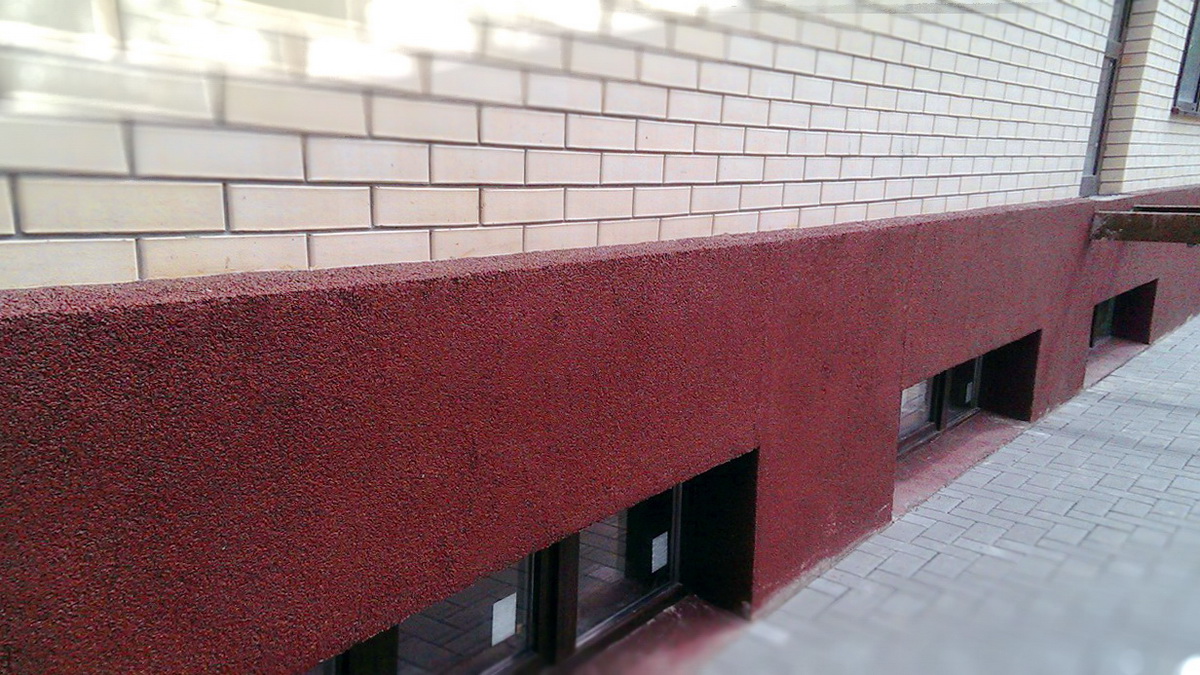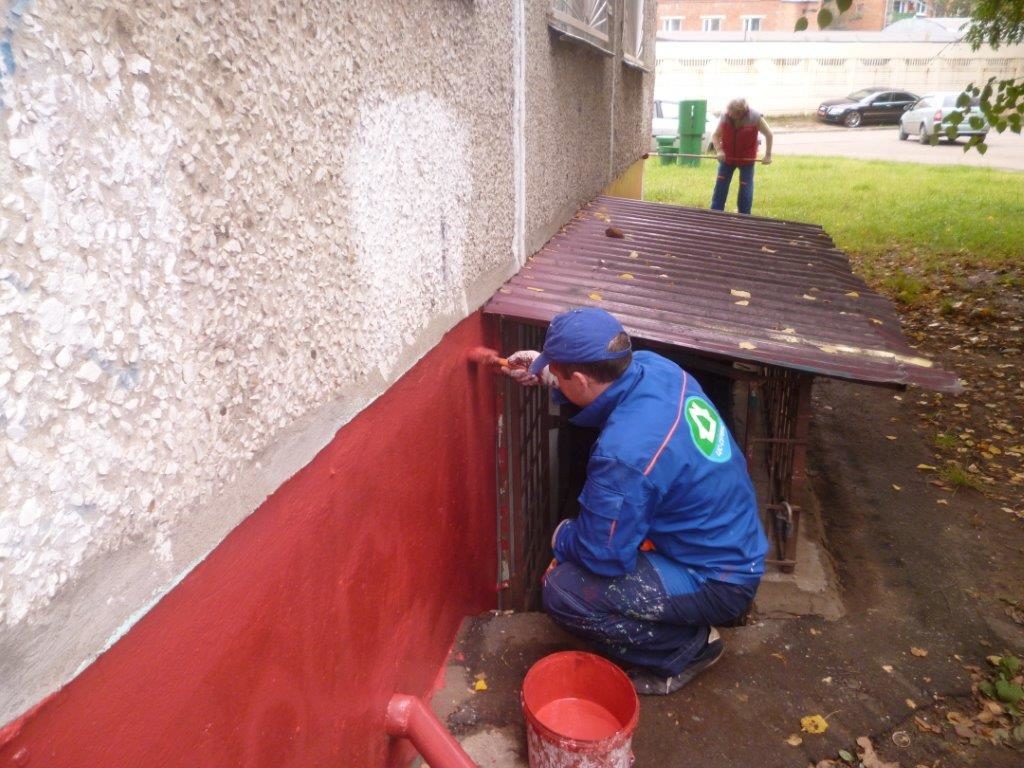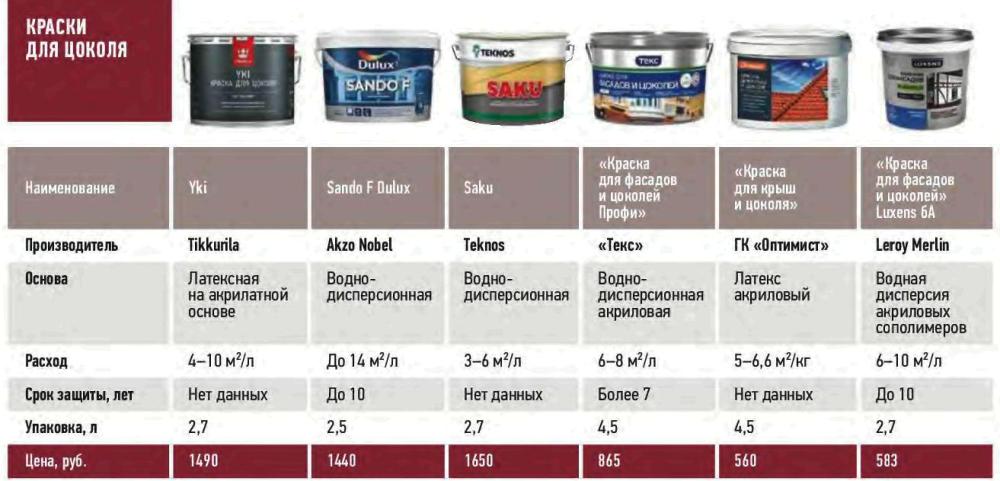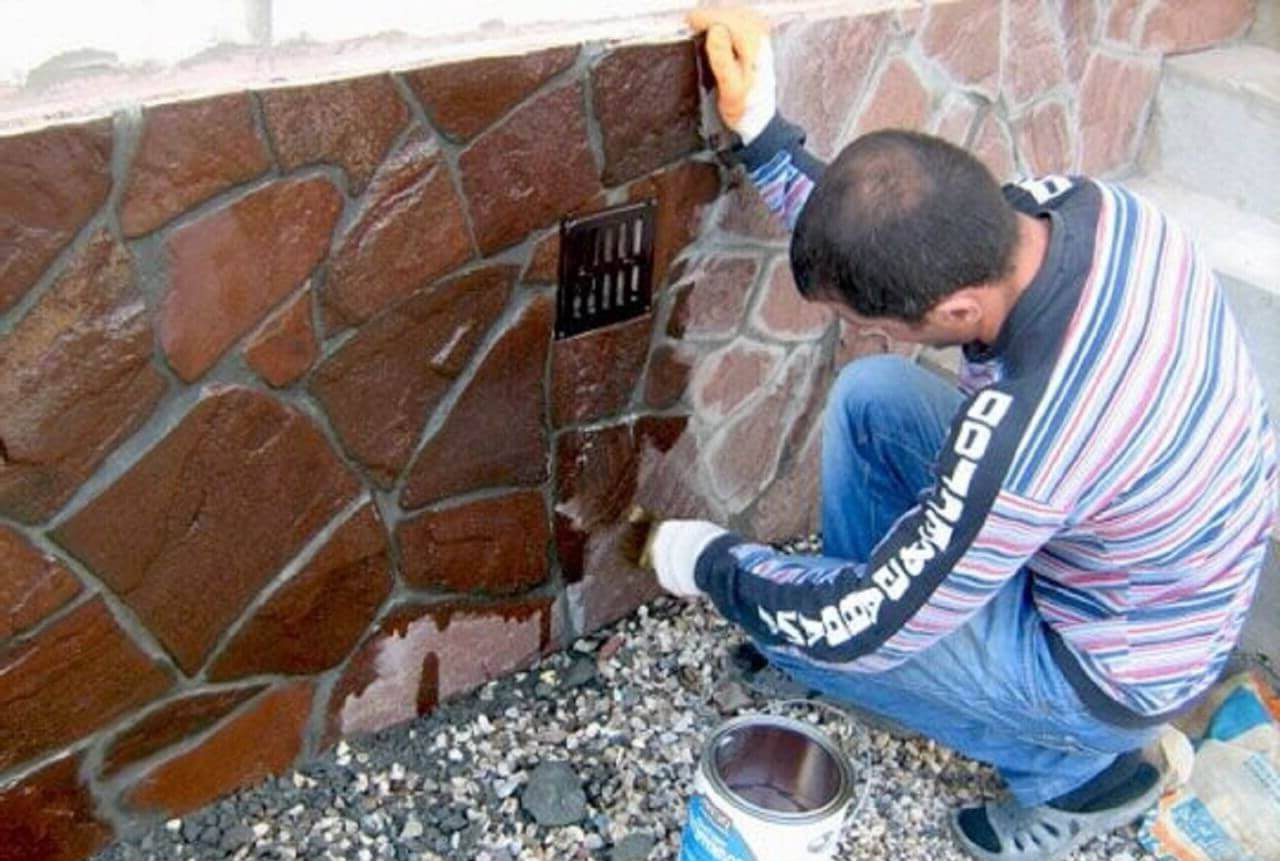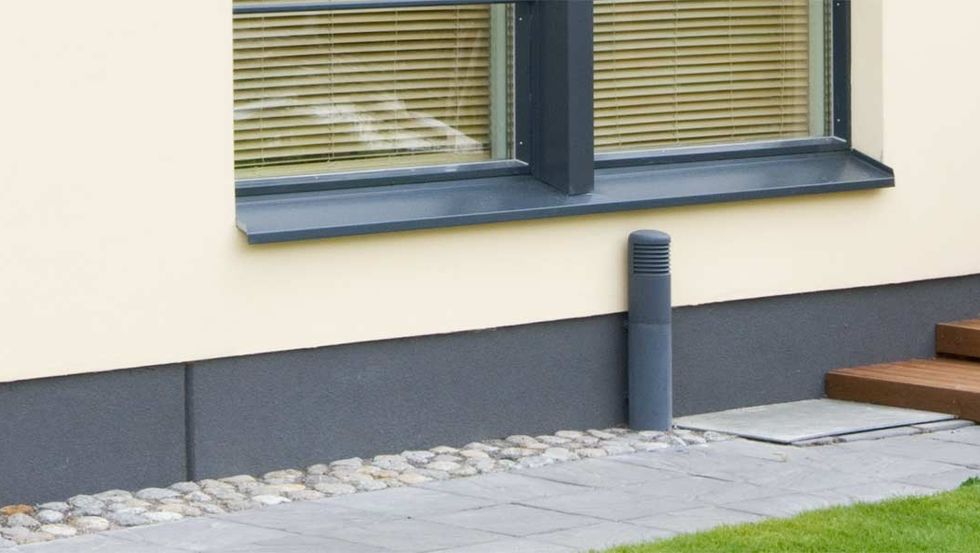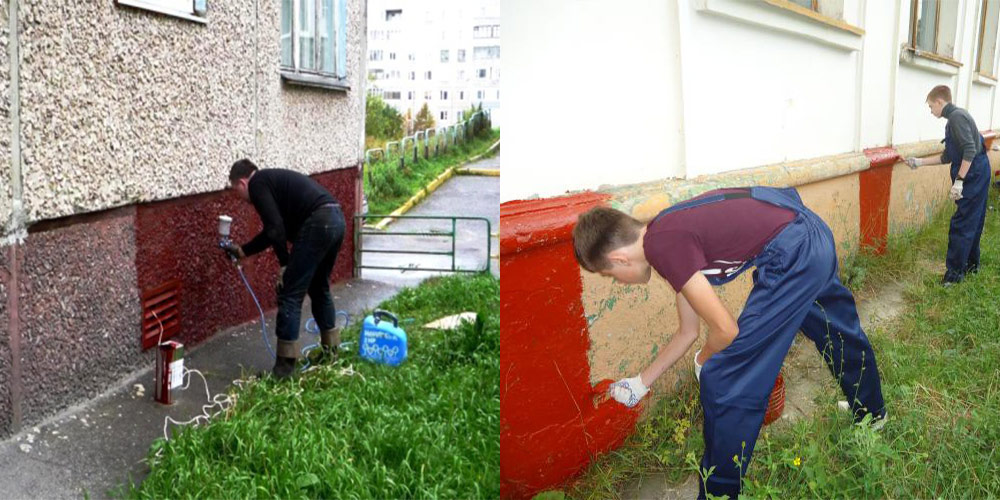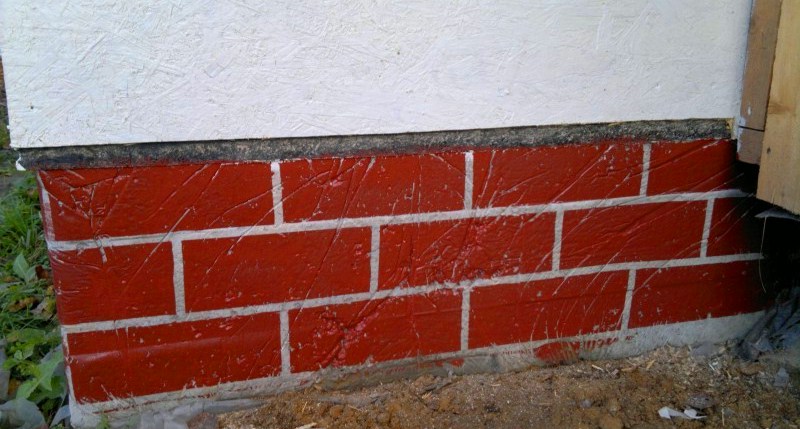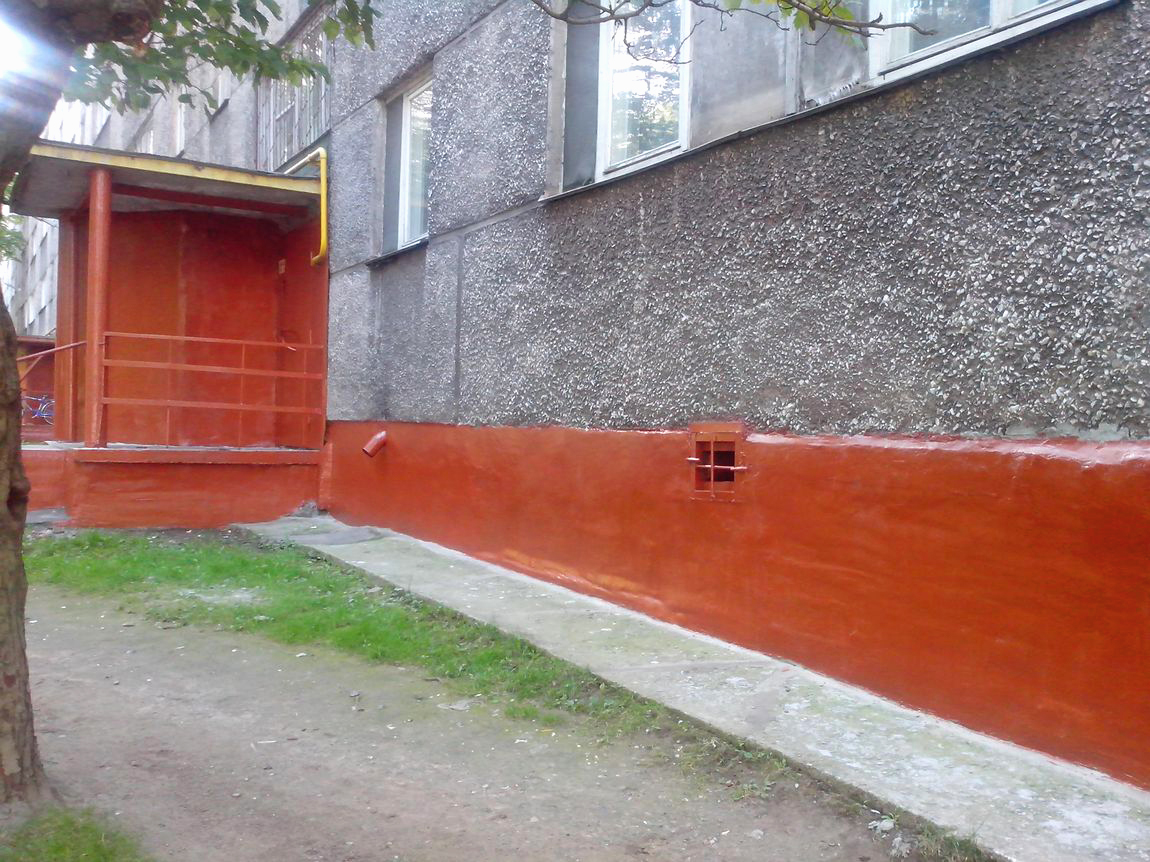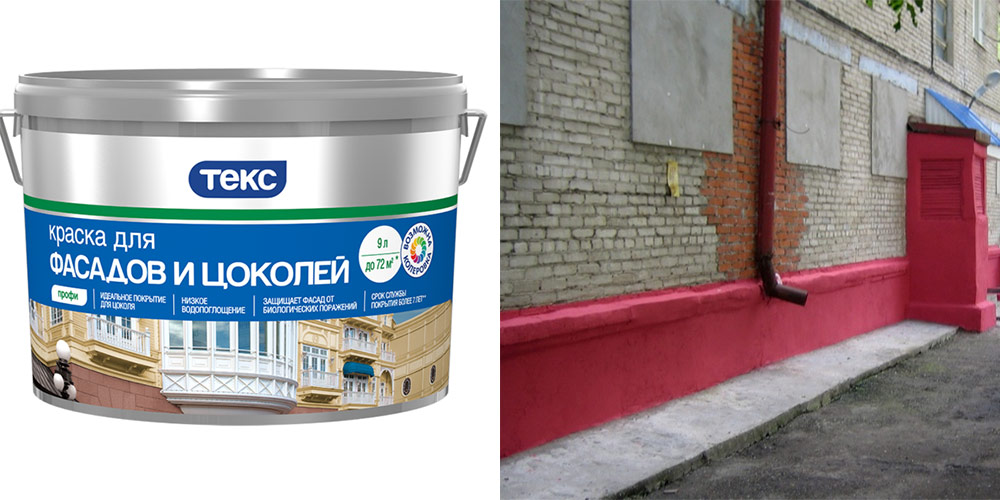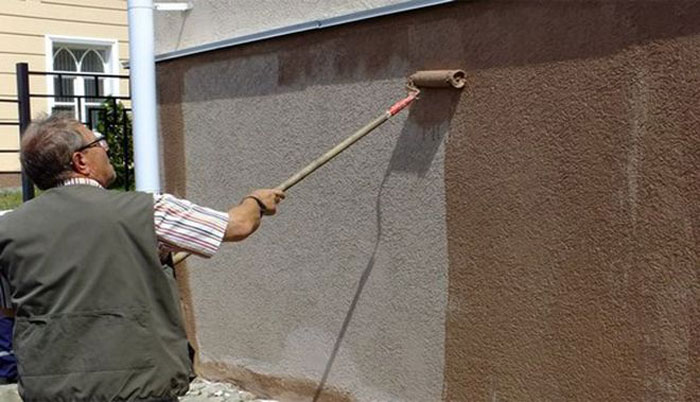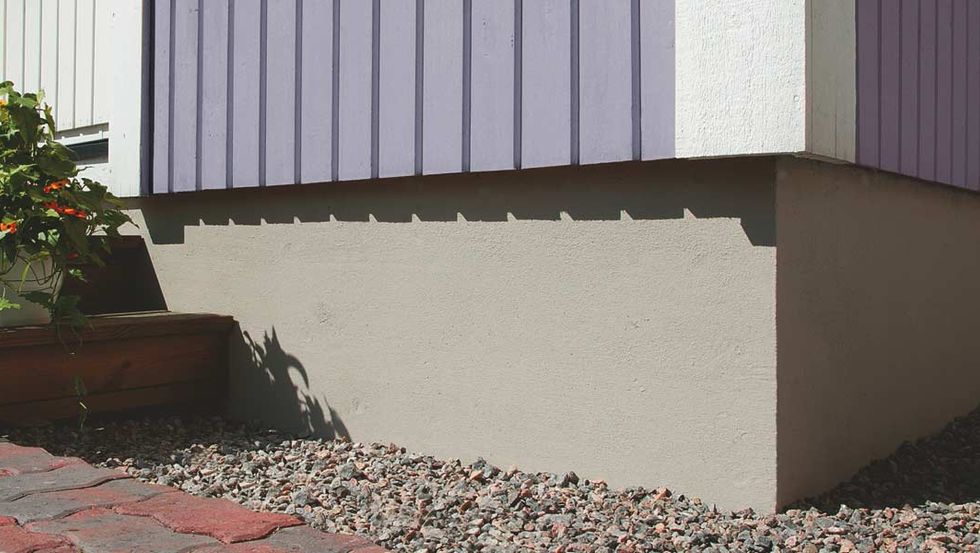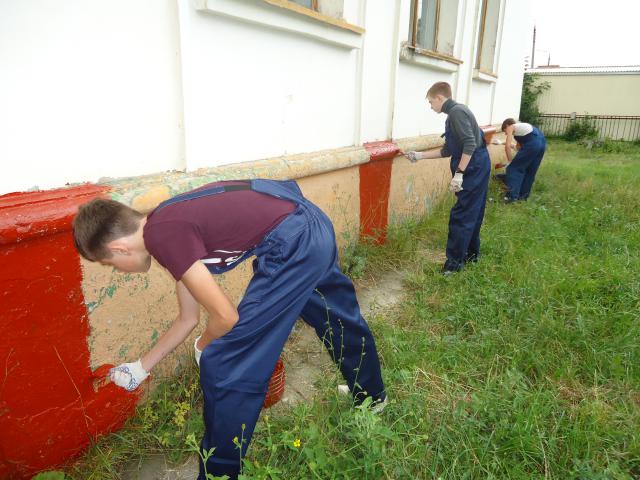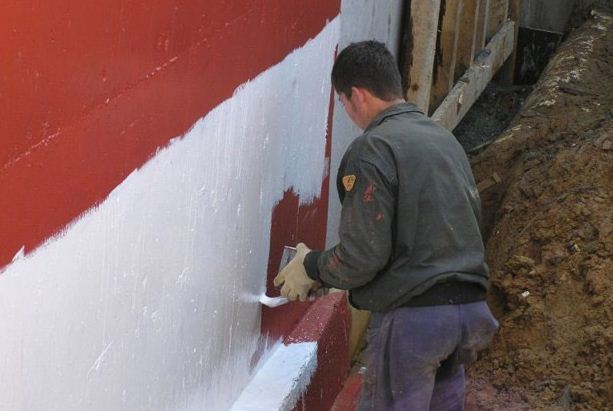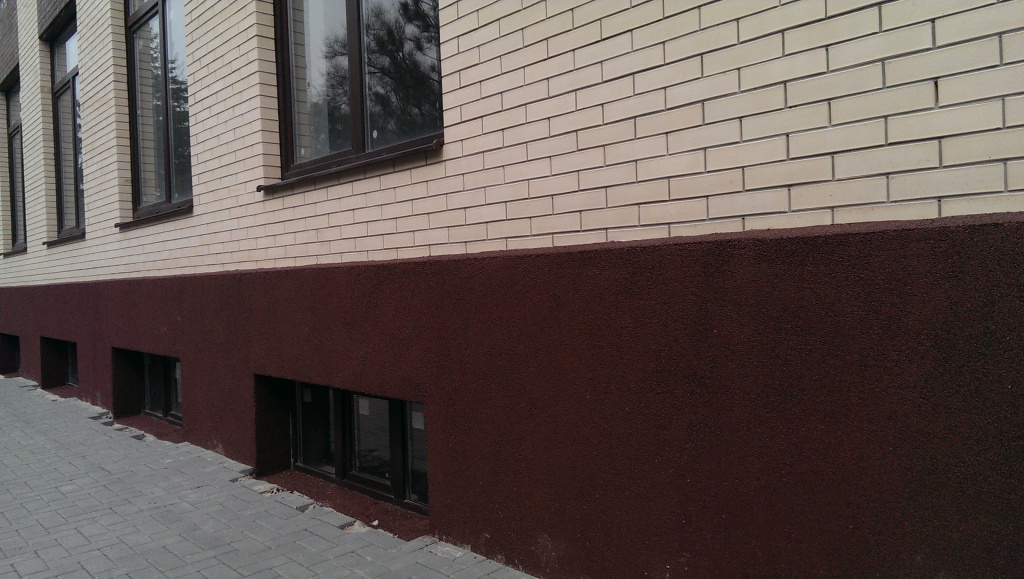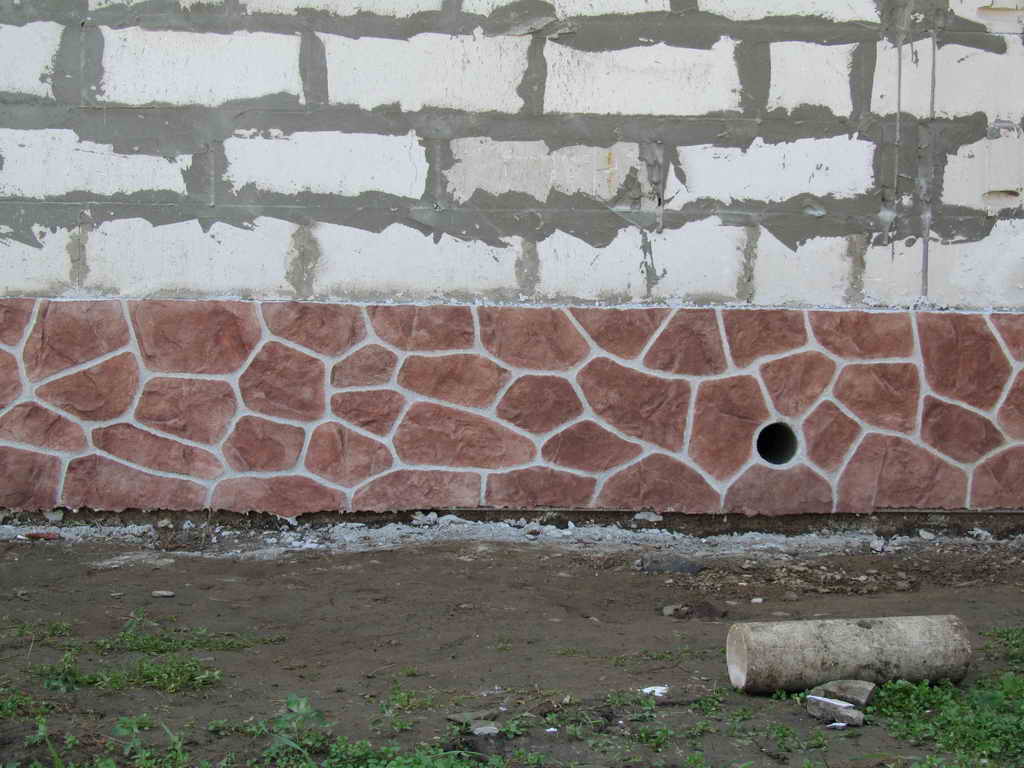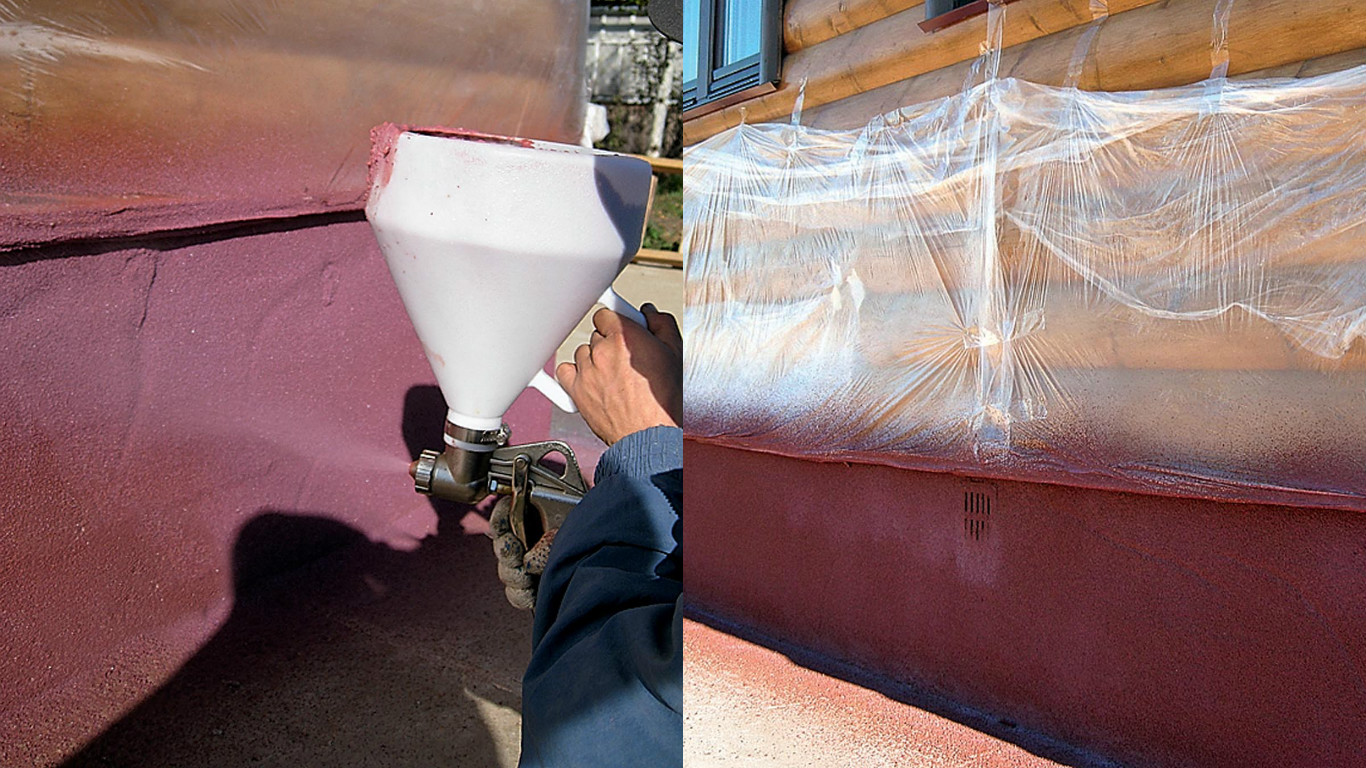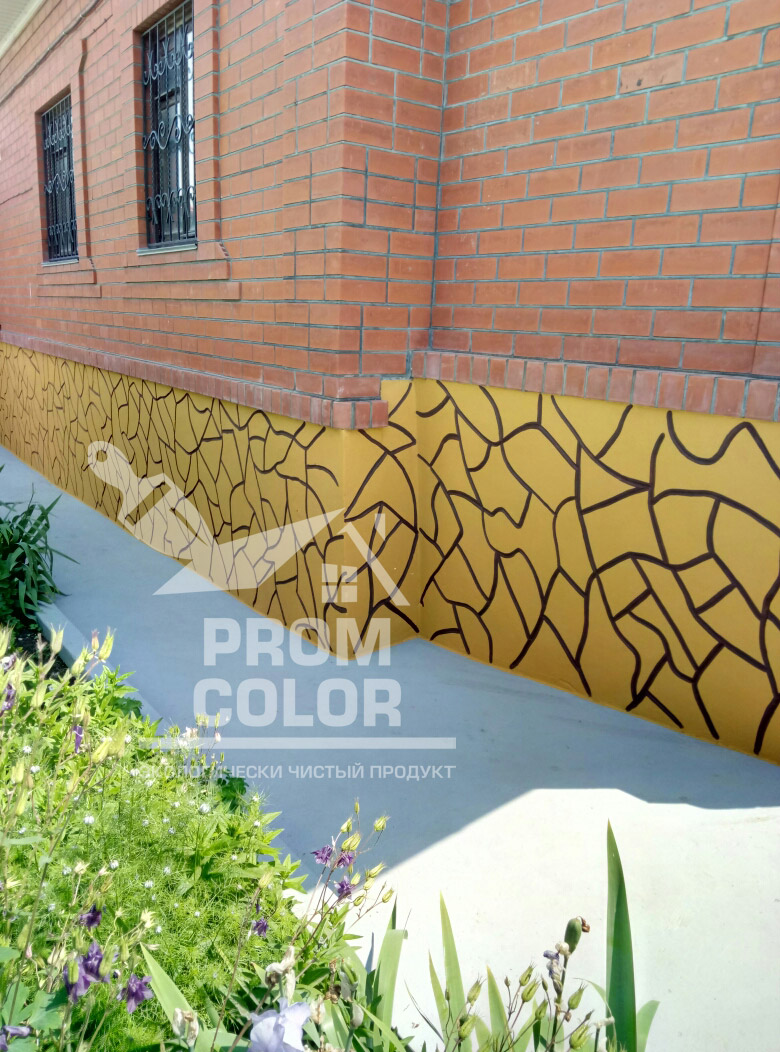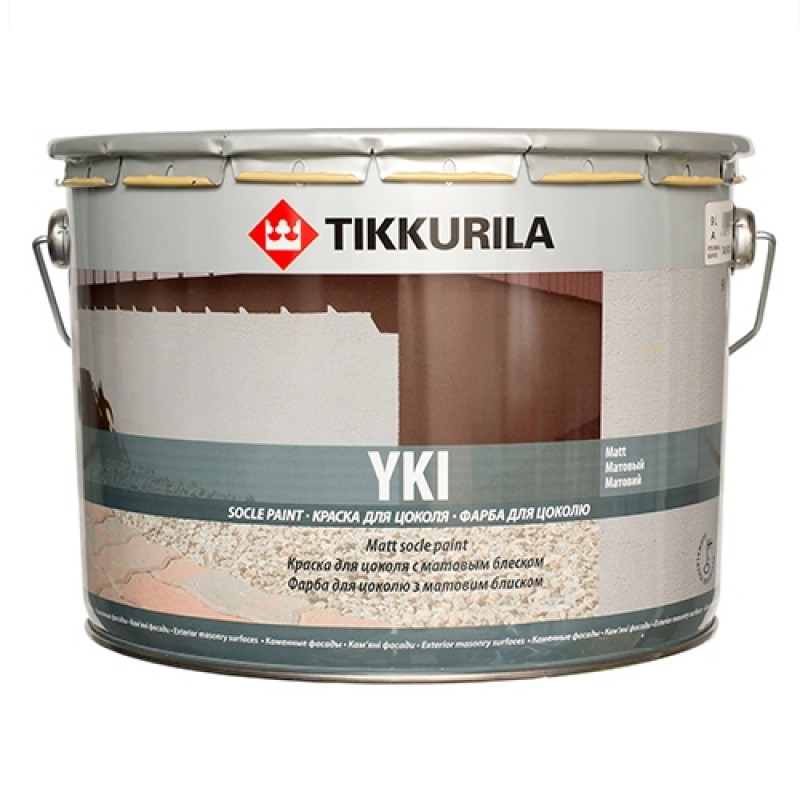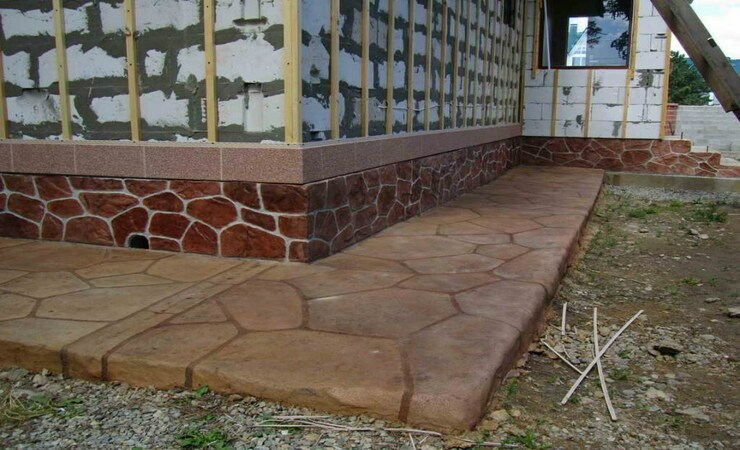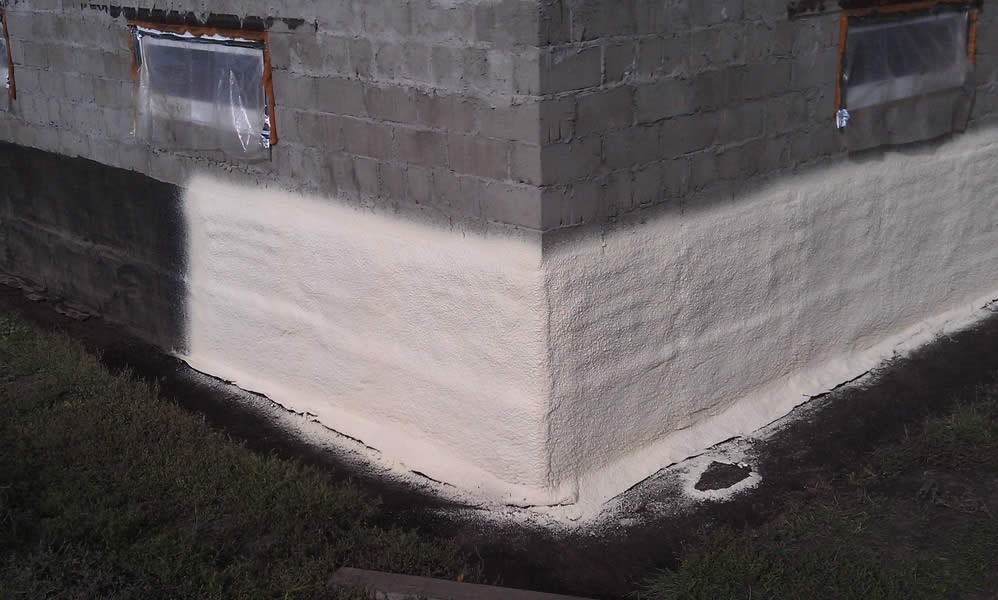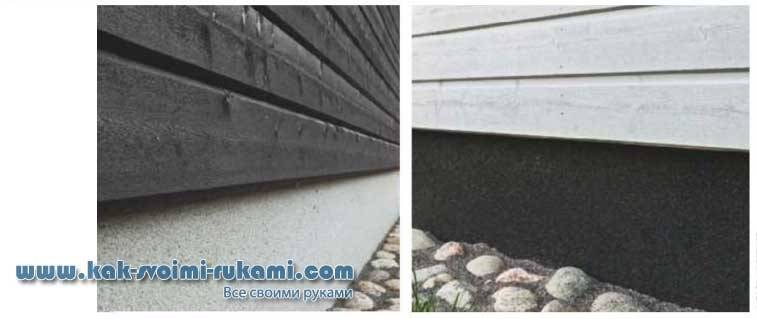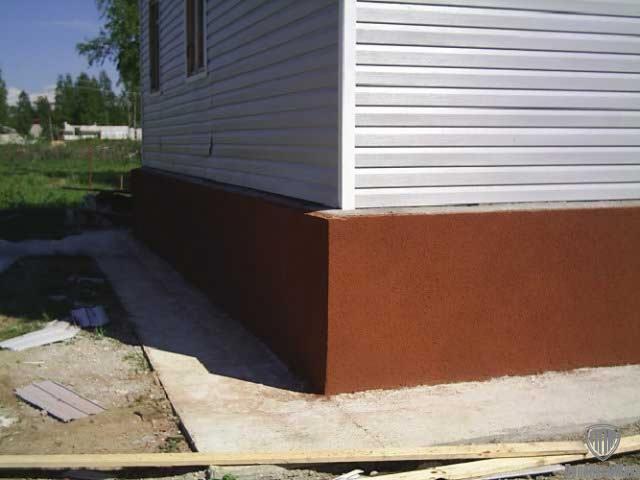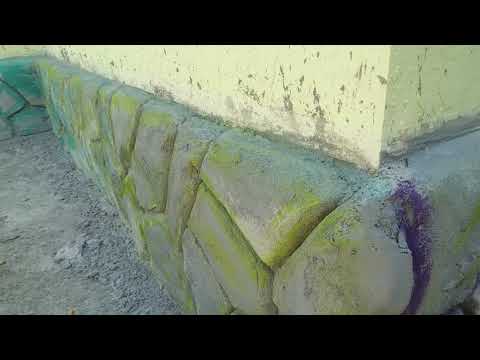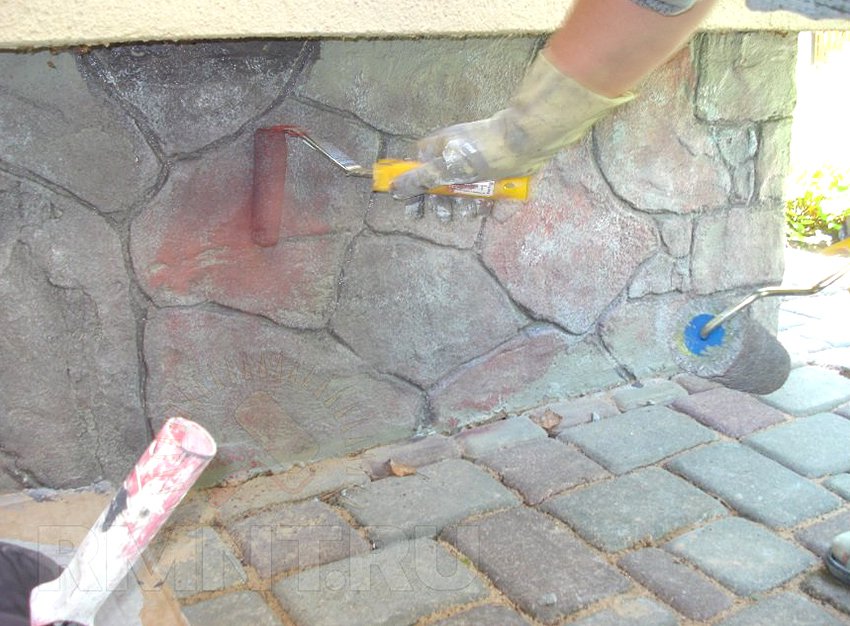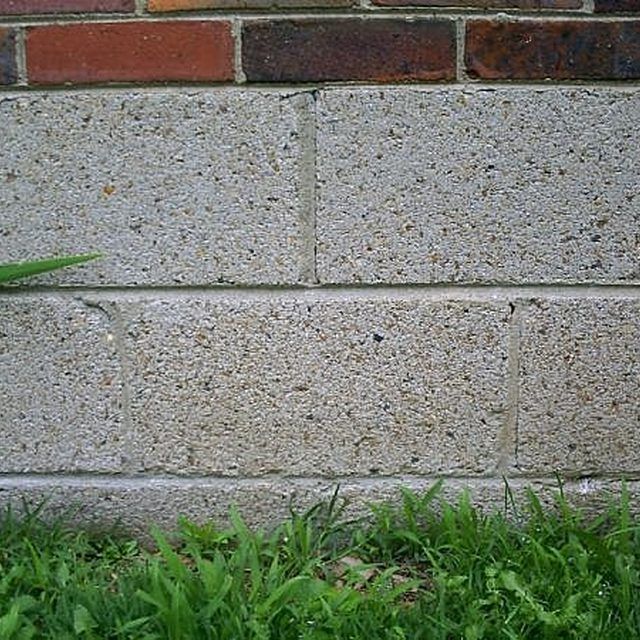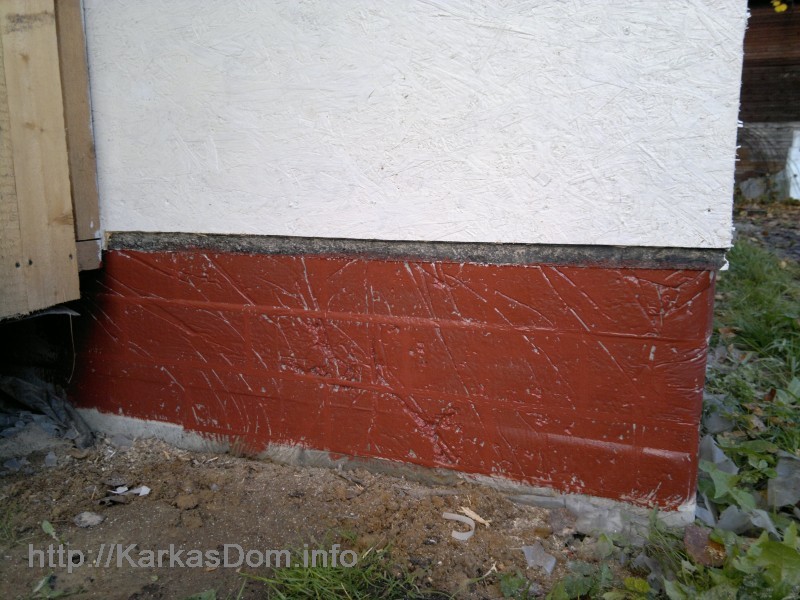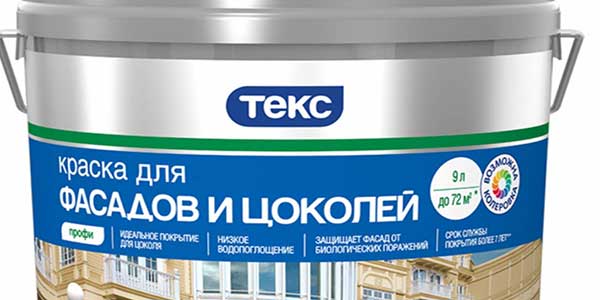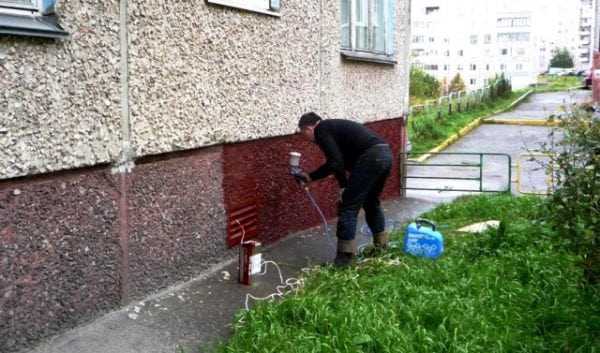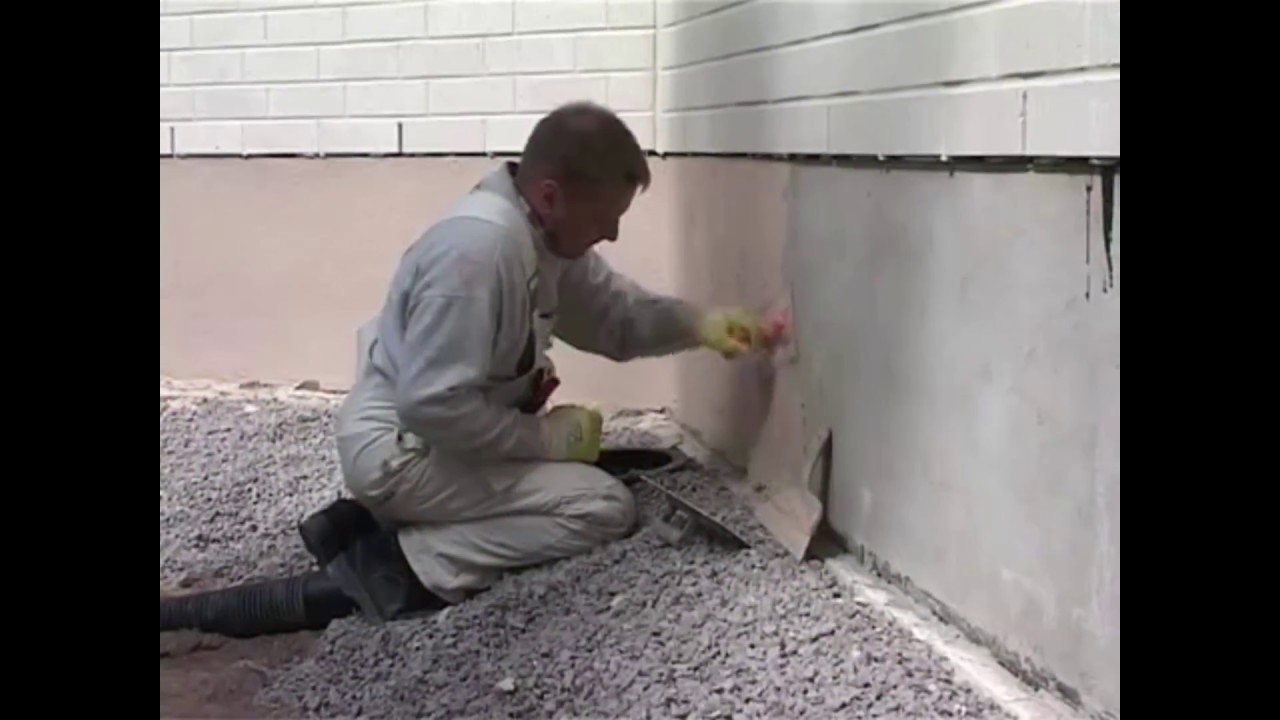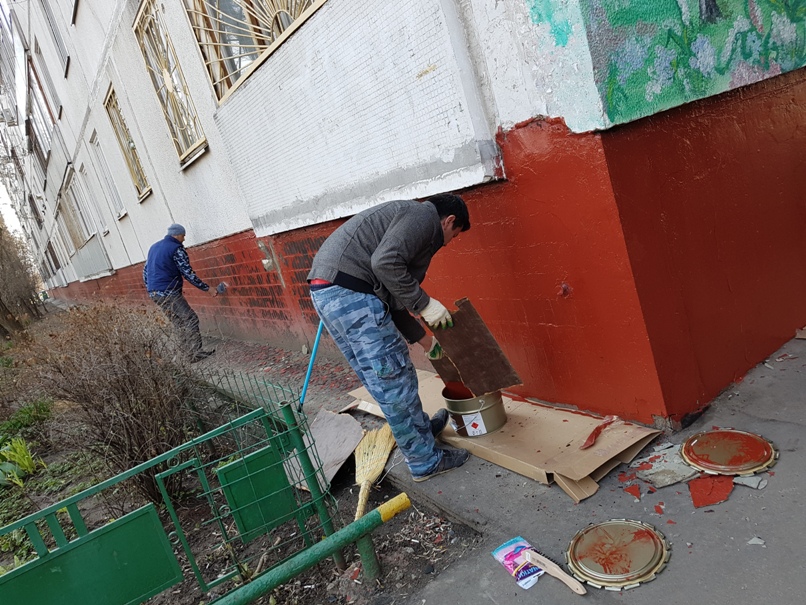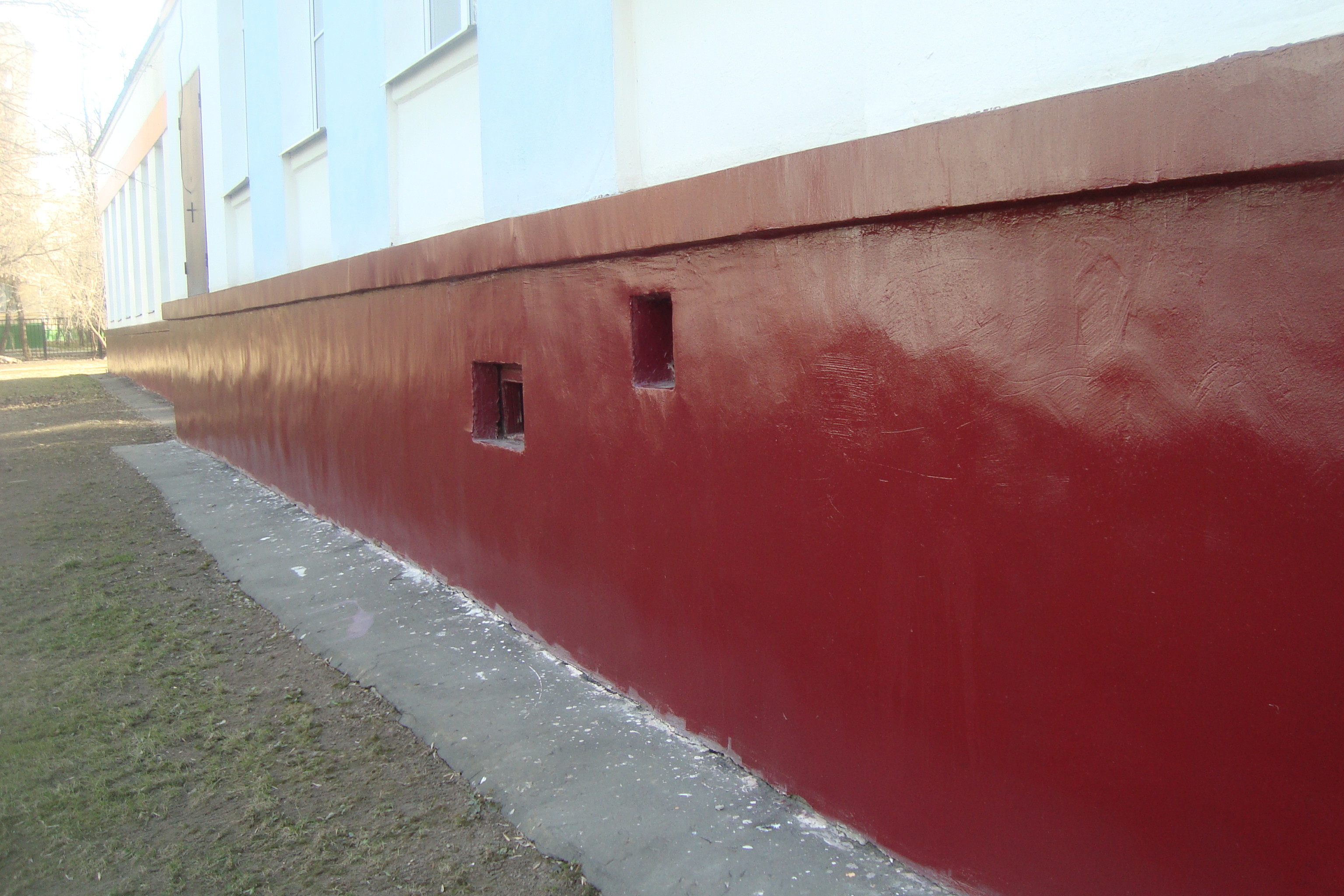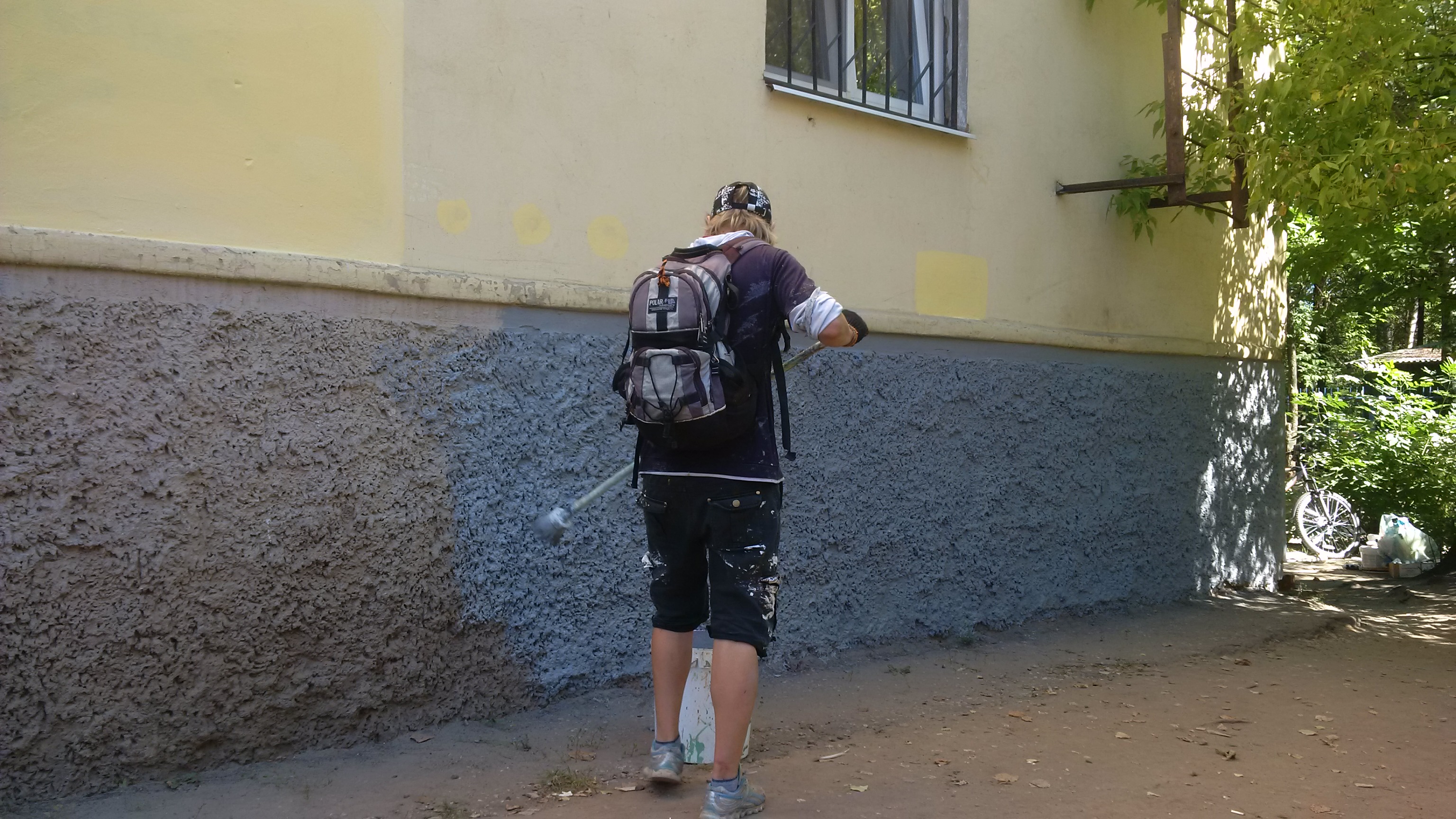Features and benefits of various paints and varnishes
Basement waterproofing scheme.
Various types of paints and varnishes can be used to cover the basement of the house. Each coating has its own characteristics and disadvantages. First of all, it should be noted that all of them are characterized by high adhesion, i.e. have excellent adhesion to the treated surface, which ensures the durability of the coating.
Both smooth and textured paints are suitable for finishing the basement of the house. To finish the surface with textured paint, you must use a roller. Such painting allows you to make the appearance beautiful and original. Matte paint will reflect the sun's rays, which will hide minor surface defects.
Water-based dispersion paint provides reliable protection of the basement of the house from any vagaries of nature and makes it almost invulnerable. Paints and varnishes also differ in composition. Available to the consumer:
- Organic formulations.
- Water based formulations.
If we talk about water-soluble paints, then these are water dispersions and various emulsions of synthetic resins. These include:
Concrete basement scheme.
- Latex.
- Silicone.
- Acrylic.
- Other.
Organic-based paints are alkyd and polyurethane. Considering in more detail the paints and varnishes available today, it is necessary to briefly describe each of them.
Before painting the basement of the house with acrylic paint, the work surface must be cleaned of dirt and dust with a stiff brush or washed with water from a hose. When finishing, you must strictly follow the manufacturer's instructions on the packaging. This paint has a number of advantages, including:
- High strength.
- Reliable wind protection.
- Protection against all kinds of chemical influences.
Water-borne paints are the most environmentally friendly and are also suitable for interior decoration. This paint is the easiest to work with. Latex water-based compositions have increased moisture resistance. This allows for frequent cleaning of the work surface. The paint provides good protection of concrete against corrosion.
Epoxy compounds provide high protection against negative mechanical influences. Using this option, you will ensure durable and reliable painting of the base. A separate advantage of this paint is the ability to apply it to fresh and damp concrete. Painting is performed in 2 mandatory stages with a difference of 12-24 hours. Polyurethane painting, in addition to a very long service life, guarantees the impossibility of "sticking" to the surface of dirt and provides reliable protection of the base from the appearance of mold and mildew.
Instructions for painting the base
After choosing and purchasing paint with the appropriate primer, you can start painting the surface of the basement of the building. They include the following steps:
- cleaning from dirt and mold;
- primary priming;
- sealing cracks and leveling the surface;
- second soil treatment;
- staining.
From a tool for painting work you will need:
- paint brushes, roller or spray gun;
- paint roller tray or other wide container;
- spatula, wire brush, hammer and chisel;
- trowel, float and short plastering rule.
In addition, a tool should be prepared for the possible mechanical removal of mortar residues and other contaminants.
Surface cleaning
Use a spatula and wire brush to remove dirt.Coarse concrete and grout residues should be chipped off with a chisel. It is also necessary to remove oil stains, old paintwork and tiles, if any.
High-quality surface cleaning is an important basis for all subsequent work.
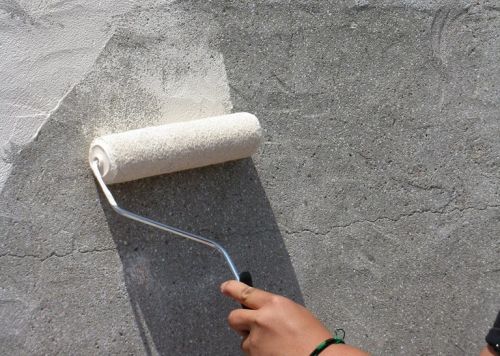
Crack filling and surface leveling
Before painting the base, it is necessary to seal the cracks and level it. Before performing this work, the base should be treated with deeply penetrating soil. This will bind the remaining dust particles and strengthen the concrete or brick surface.
Cracks should be filled with a cement-sand plaster mortar prepared with a ratio of 1: 4. To improve the quality, it is recommended to add a plasticizer or liquid detergent to the solution.
At the first stage, it is necessary to carefully seal all cracks in excess of 2 mm in width. Level the surface after two days. In this case, it is not necessary to completely plaster the surface. It is enough to fill only the grooves with mortar and level it with a plastering rule. Subsequent work should be done in 4-5 days after the solution has completely dried.
Plinth painting
Before painting, the surface must be primed again two times and allowed to dry within 24 hours. This is to strengthen the places where the leveling layer is applied.
Paint can be applied with a paint brush, roller or through a spray gun. The latter option gives the best quality coating, but requires special equipment. After applying the first layer, you need to wait until it dries completely in accordance with the instructions for use of the material and only then apply the second layer.
 Spray gun painting scheme.
Spray gun painting scheme.
Foundation staining
Speaking of painting the foundation, they mean ensuring the protection of its above-ground part, which is built of concrete or brick and, in fact, is also a plinth. Therefore, the choice of materials and the technology for painting the upper part of the foundation are no different from the technology for processing the basement, which is described above.
Performing painting works
All work can be done on your own, if you adhere to certain recommendations. The algorithm of actions is as follows:
- the concrete surface is preliminarily cleaned of mortar residues and dirt, for which a stiff brush and water supplied under pressure are used. After this, the foundation should dry well;
- with the help of a shovel, the sod is removed in front of the foundation base, a blind area is planned;
- chips are processed, puttyed with a cement-based solution. It should be kept for at least a day for the liquid solution to dry and become suitable for applying a second layer;
- a special primer is applied with a roller, which fills the pores of the base and improves the adhesion of paint to concrete;
- the coloring composition is diluted to the required consistency with solvents or water, filtered to remove the remaining lumps;
- use rollers and brushes for application; on large areas it is better to use a spray gun.
Acrylic paints for concrete walls
Most often, acrylic compounds are used for wall decoration (both internal and external), which are divided into organic and water. Solvent-based paints form a coating with high mechanical strength, resistant to temperature extremes, moisture and other aggressive influences.
Many of them (for example, "Akrial-Lux" from KRASKO price - 140 rubles / kg) allow work in winter. And yet, in private homes, organic paintwork materials are rarely used. The reason is a strong unpleasant odor, difficulties with tinting and a relatively long drying time.
Water-soluble acrylic paints are devoid of all these disadvantages. But they are inferior to "organic" in terms of strength and durability of the coating.However, in suburban estates, the load on the facades and internal walls of buildings is much lower than in industrial zones, therefore, most often, owners of private houses prefer water-soluble emulsions. They are produced by almost all large "colorful" companies, both domestic and foreign. The average cost of a product at the moment is 125-200 rubles / kg.
Another option for finishing concrete walls is alkyd enamels.
Interestingly, they can be used not only on mineral, but also on metal and wood surfaces. The paint layer adheres firmly to materials with completely different properties thanks to the binder - alkyd resin.
When exposed to air, it cures to form a smooth and flexible coating with good adhesion. Alkyd compounds are extremely durable (much stronger than acrylics), but it should be borne in mind that they are organosoluble. with all the ensuing consequences - unpleasant odor, long drying time, etc. The cost of products of this kind is relatively low.
For example, the price of PF-115 universal enamel from TEKS in a 2.5 kg container is about 500 rubles. Alkyd enamels come in three gloss levels: glossy, semi-matt and matt. For outdoor work, it is reasonable to give preference to the first type - a smooth paint layer lasts on average 15-20% longer than a rough one.
How to paint the foundation of a house made of cement?
The foundation is the foundation of the whole house. It is he who is the key to the stability of the walls and the duration of the operation of the house. Therefore, the foundation must be reliably protected so that subsequent destruction and cracks do not occur. It would seem that cement itself is strong. However, over time, it can crack, crumble. To prevent this from happening, the foundation of the house made of cement must be covered with special protective paints and varnishes. The construction market offers a wide range of paints, and today we will consider what paints are and which ones are better to give preference for the protection and long-term functioning of the foundation.
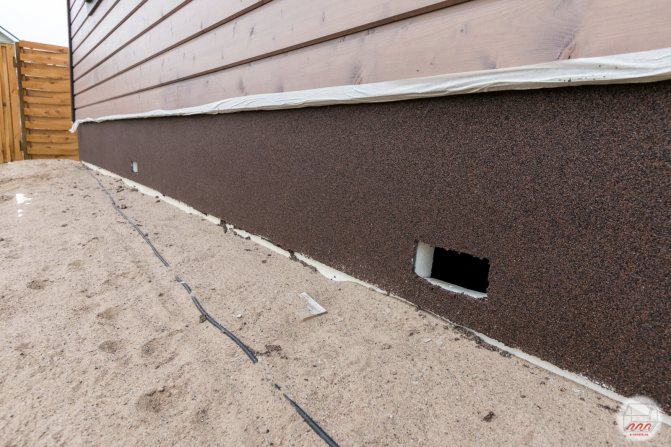
Acrylic paint. Quite popular paints and are widely used to paint the foundation of a house. The advantages of the paint include: ease of application, quick drying, good adhesion, withstands temperature changes and mechanical stress.
Latex paints. The composition of the material includes a special pigment, water, polymers. It is not often used for staining the foundation, but, nevertheless, it has a lot of advantages: it fills microcracks, frost resistance, moisture resistance.
Epoxy paints. A good material that protects the foundation of a house for up to 25 years. Advantages: vapor permeability, moisture resistance, resistance to temperature changes and ultraviolet radiation, resistant to alkaline solutions.
Polyurethane paints. The paint improves the properties of concrete, is chemically resistant, frost-resistant, fills microcracks and pores of cement, forms a protective film.
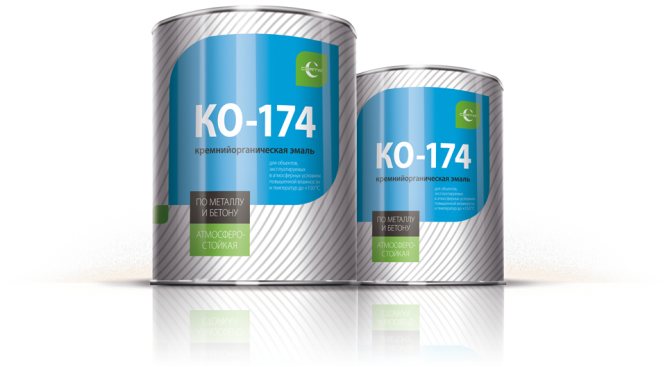
Alkyd paints. They are also very popular when painting the foundation of a house made of cement. The advantages include: fast drying, resistance to ultraviolet radiation, resistance to low temperatures, economical consumption, deep penetration into cement, resistance to alkali.
Despite all this diversity, experts recommend using KO-174 silicone paint for painting the foundation of a house made of cement. The paint can withstand high temperatures up to + 150 ° С, while being frost-resistant, resistant to mechanical and chemical influences. It penetrates well into the pores of cement and fills all microcracks. In addition, the coating has water-repellent properties, is easy to apply and is presented in a large color palette, which means that you can paint the foundation of the house in any desired color and not only protect the concrete from the external environment, but also give it an attractive appearance.
Painting the foundation with “KO-174” paint can be carried out in winter, when the temperature can reach -35 ° C and in summer, at + 40 ° C.
If you are looking for reliable paints and varnishes at affordable prices, feel free to opt for KO-174 paint. And you can order paint at EGO LLC.
Preparatory activities
The preliminary stage is necessary to create the possibility of performing the main task - protecting the concrete fence by coating with paintwork materials.
Preparation consists of several sub-stages:
- Step 1. Cleaning from contamination. It is made with a metal brush, a scraper spatula. The operation is performed manually or with a mechanical tool (drill, grinder, sandblasting machine). The loose parts of the fence surface are removed. If possible, it is advisable to rinse the surface with a strong jet of water with the addition of detergents or cleaning agents.
- Step 2. The damaged surface is being repaired, cracks are repaired. A cement mortar is used, ready-made or made by yourself. In the latter case, the proportions of cement and sand are 1: 3 (in weight units). Water is added until the mixture is creamy (like a toothpaste).
- Step 3. The smooth surface is roughened. An abrasive flap wheel (for a small area) or sandblasting device is used.
- Step 4. Places affected by mold or fungus are treated with an antiseptic. The substance must be difficult to wash off and used for outdoor work.
- Step 5. Metal protruding parts are coated with a rust remover or painted with 3 in 1 primer-enamel (rust converter-metal primer-enamel).
- Step 6. The final preparatory operation is concrete impregnation. The primer is applied with a roller (on a flat surface). In hard-to-reach places, adjoining adjacent surfaces, corners, a paint brush is used. The composition should be used for outdoor work (facade group), have the property of deep penetration.
Washed off priming
The impregnating composition is necessary for:
- Filling concrete micropores with moisture-resistant polymer. This reduces the consumption of paintwork materials.
- Improving adhesion. The new coating enhances its adhesion to the painted surface.
- Bonding fragile grinding solid microelements remaining after cleaning and repair operations. Removing dust residues.
Impregnating compounds are available ready-made or concentrated. The main components are acrylic polymers, silicone, antiseptics, water or organic solvents. The main requirement is the possibility of using it for outdoor work (outdoors).
Varieties and specifications
Common to all water-based paints is the water base and the emulsion type of the coloring pigment. Distinguish paints by the composition of the binder, which provides the desired characteristics for a specific application. The most common types of water-based paints are:
- acrylic;
- silicone;
- silicate;
- mineral;
- latex.
The paint consists of purified water, which serves as a solvent, a coloring filler containing one of the above bases, as well as various plasticizers and additives.
In addition to the binder, the main distinguishing characteristics of paints are:
- water permeability;
- density;
- application area.
For quick drying of the paint after application, special hardeners are used. Depending on the expected working conditions, thickeners or additives based on antifreeze are added to the composition.
VEAK
VEAK 1180 paint is one of the most common types of water-based paints. This type of paint is produced in accordance with GOST 28196-89, according to the requirements of which, all products meet the following characteristics:
| Density | 1.4 g / cm |
| Viscosity | From 30 s / m |
| Drying time | 1 hour |
| Abrasion resistance | 3.5 μm / kg |
| Mass fraction of non-volatile compounds | 53%-59% |
| PH | 6,8-8,2 |
It is an acrylic-based paint used for interior decoration. All paint of this type is exceptionally white, but due to the possibility of tinting, it can acquire any color and shade.
Water-based acrylic
Acrylic-based paints are universal, and include a whole group of varieties, classified according to OKPD 2 number 20.30.11.120. This paint is used indoors and in the production of facade work. At the same time, the acrylic base is the most expensive of the water-based paints.
Acrylic paint is very durable, with a lifespan ranging from 5 to 20 years. The paint is applied to almost any surface, evenly distributed over the plane. After drying, the paint creates a fairly dense layer that is poorly permeable to air and other substances. Also, a strong advantage of this base is considered to be high frost resistance and resistance to temperature extremes.
Latex
Latex paint contains rubber, which gives elasticity to the applied layer. This type is also used both indoors and outdoors. There are different types of paint, and it is divided not only by the area of application, but also by the characteristics of the finished surface in terms of gloss. Distinguish:
- CM is completely matte;
- M matte;
- MP is half matte;
- PG is half glossy;
- G glossy;
- SG is completely glossy.
This type of paint is used to create a three-dimensional texture of the painted surface. Like acrylic paint, latex calmly transfers contact with water after the surface is completely dry.
For concrete for outdoor use
Most water-based exterior paints are based on acrylic, latex or silicate, including those for concrete. Such coatings are not only decorative, but also protect concrete from moisture and ultraviolet radiation.
The paint should be applied in a dense layer and fills in all the small irregularities of the surface, forming an even, uniform layer. Facade paint for concrete must have the following characteristics:
- high rate of adhesion, that is, "sticking" to the surface;
- strong moisture resistance;
- high abrasion;
- UV resistance;
- vapor permeability, for the possibility of evaporation of water and other substances from concrete;
- high resistance to dirt.
For outdoor woodwork
For such types of work, the requirements for paint will be even stricter, because wood, unlike concrete, is prone to decay. If you use paint that is permeable or even more absorbing water, then the surface will quickly become unusable, and this will affect not only the appearance, but also the strength of the structure as a whole.
The general characteristics of paints will be the same as for concrete, but paints specially formulated for wood are easier to apply and will hold better. Today, there are water-based coatings with antifungal additives that provide additional protection.
Plinth painting
Yuuki paint is intended for painting concrete plinths, as well as for flat surfaces of foundations. Painting the basement is a rather responsible matter, since it is constantly exposed to atmospheric conditions, mechanical and chemical stress. The base needs to be treated with protective agents in the form of impregnations, primers. The protective coating is applied to the plinth according to the recommended technologies. The applied coating should be impervious, which will provide the base of the house with reliable protection. The choice must be stopped on a composition that provides reliability and durability.

In addition, the paint must be compatible with the material from which the base is made. It must be selected in conjunction with a primer. Paints and base / plinth primers must be resistant to aggressive environments.The chemical load is especially high in large cities.

Reliable adhesion of the paint to the surface of the base will ensure its protection and durability of the coating. Acrylic dye has a number of undeniable advantages. Its advantages are as follows:
- resistance to chemical attack;
- long term protection of the painted surface;
- moisture resistance;
- strength and reliability.
Epoxy paints also create a reliable coating for the surface of the basement, foundation. Such protection is applied even to fresh concrete after it has dried, and guarantees its long-term protection for many years.
Characteristics of foundation paints.
Water-based acrylic dyes are composed of acrylic resins and their copolymers. Painting the foundation with such paints allows you to get a polymer layer on the surface, thereby protecting it from both mechanical and chemical effects of the environment. Such dyes have a number of features:
- Easy to apply, with just one layer;
- Dry quickly;
- After drying, they become waterproof;
- Differ in efficiency. So, to paint a square meter of the surface, you need only 0.35 kg of Proacryl and 0.4 kg of Acrylic Lux.
The latex added to paints makes them resistant to cleaning. They are water-repellent and resistant to temperature changes. The fact is that latex can stretch, thereby filling the resulting microcracks. Such paints dry quickly (no more than 4 hours between coats) and are economically consumed (a liter of A-100 Exterior Acrylic Latex is enough to paint a surface of 8-9 sq. M.). They should be applied while the concrete is still fresh, but the air humidity should not exceed 50%.
Epoxy paint for a period of up to 25 years will provide the foundation with protection from various harmful influences. This coating is breathable, resistant to sun rays, alkaline and acidic environments. The foundation can be painted with epoxy both on fresh concrete (thus a better coating is formed), or in two layers. In the latter case, the paint will dry for 24 hours. It consists of two components and therefore requires kneading.

Nowadays, there are paints on the market that are suitable for both previously painted and not yet treated surfaces. In the latter case, 3-5 kg will be consumed per square meter. paints (for example, "Tapping R 1155"). To apply the POLAC EP-52PA primer enamel, no preliminary priming is required.
The use of polyurethane enamel makes it possible to obtain a glossy finish, which, moreover, will be durable and resistant to the effects of various chemicals.

As mentioned above, the two-component enamel should be mixed before application. It can penetrate 3-5 mm in depth, forming a polymer film (the thickness of the "ELACOR-PU" layer is 200 microns). The paint layer consists of crystals that clog the micropores of the concrete, thereby excluding flaking. The foundation treated in this way is heat-resistant. It will not collapse and collect dust even if grades below M-100 and are used. Such a coating can last up to 15 years at sub-zero temperatures. It turns slightly brown when exposed to sunlight. The paint should be applied in two layers with a break for a day. After a week, the coating acquires maximum resistance to mechanical stress, two - to chemical ones.
Alkyd dyes contain a resin that is extracted from vegetable oils by cooking. The addition of desiccants accelerates the drying of the paint layer. After being applied to concrete, this paint penetrates deeper into it than aqueous emulsions. The surface becomes resistant to detergents, sun rays, frost and precipitation, dries quickly (one layer - 20 hours). Alkyd paints are very economical. So, for 1 sq.m. 180 g of PF-115 enamel is enough.The disadvantage is that it should be applied in two to three coats. In addition, this paint is fire hazardous and therefore more suitable for outdoor work.
Oil paints are also suitable for the basement surface. They include drying oil, which is made from vegetable oils, and pigment fillers. In order for the layer of oil paint to dry, it takes a day (at a temperature of about 20 ° C). After that, a film is formed, which is distinguished by its density and strength. Such paints are inexpensive. Their disadvantage is that adhesion and elasticity deteriorate over time, and the color fades. They can be used to paint the foundation after the concrete has hardened. Oil paints are used sparingly (for 1 square meter, 250 g "MA 15 EXPERT" is enough).
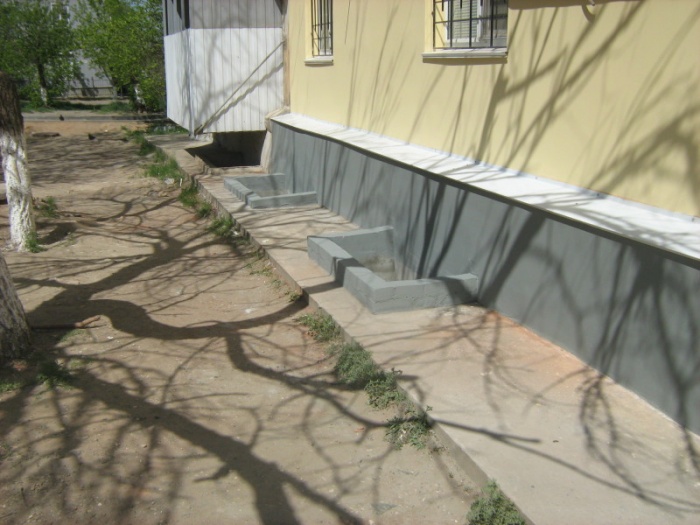
What materials to choose for decoration
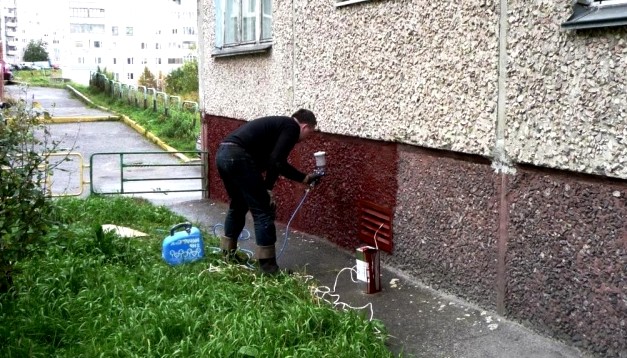
Good base / plinth paint will extend the life of any base structure
Today manufacturers offer a lot of interesting things. Including paints and varnishes that need to be diluted with plain water. There are options diluted with thinners, solvents. If you read the instructions carefully, it will say there that you should buy a suitable primer along with the paint for the base.
Only when these two components are chosen correctly and used together can you expect excellent results.
The choice of paint - what is worth buying
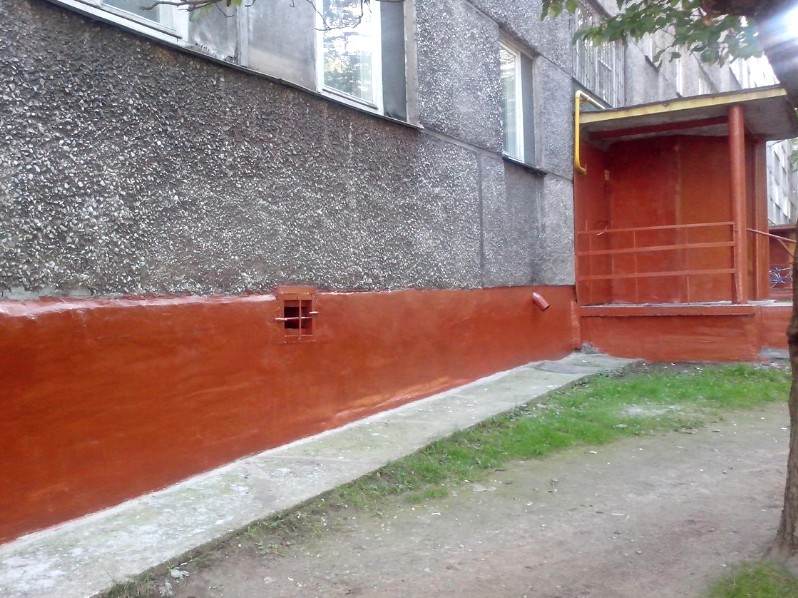
The basement has already been painted here - the house now looks completely different
The paint today (including for the base) can be textured and smooth. This greatly expands the design possibilities.
In more detail, then:
Most often, acrylic paints are used for application to the basement, which are diluted with water (this work is not just painting the wall, but there are similar points). This material is actually well suited for stone, brick or concrete surfaces. The materials are moisture resistant, while they have a suitable vapor permeability. It is also worth noting frost resistance, excellent adhesion
The finished result does not fade - this is also good;
You can pay attention to alkyd and polyurethane compounds. These paints are formulated with synthetic or organic solvents.
They do not react to alkaline media, as well as to temperature drops. Ultraviolet light, water, mechanical stress - all this does not play any role, you don't even need to worry. This paint for a basement on concrete will last a very long time - if it was applied with the recommended primer (information about it can be found in the instructions);
You should also pay attention to silicone paints. These compositions have proven themselves on the positive side - on those surfaces that are highly porous. The product is not cheap, but it is of high quality. Such paints do not interfere with a couple, they do not allow moisture to pass through, and air is without problems, for this they are appreciated;
An interesting option is polyvinyl acetate paints. They have an adhesive base (PVA) and are easily diluted with water. These compounds are cheap but wear out quickly. It is enough to perform several cleaning cycles - and the quality of the layer will significantly decrease, you should take this into account when buying;
Enamel compositions - these materials are sold on resin and varnish, can be on polymers. For dilution, special solvents are used. Among the pluses are complete water resistance, gloss, durability and bright colors. But for human health, such options are not safe. There are plenty of chemicals in the composition and this should not be overlooked. Another drawback is that the enamel layer will not let air through, such is its specificity;
If you need to protect the bottom of the facade from high temperatures, you can use fire retardant paints that are used for metal. A bright representative is "Polistil". They put it on an iron base.A plinth treated with this material will cope without problems even with serious heating. Or to veneer the basement with granite is expensive, but for centuries.
Exterior work and soil selection
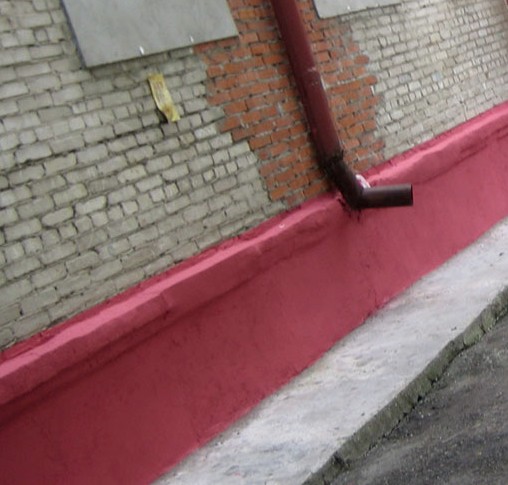
In addition to paint for the plinth, you need to choose a suitable primer.
In order for the paint to adhere better to the main one, as well as in order for its positive qualities to be enhanced and, as a result, a decent decorative coating is obtained, it is advised to perform a preliminary priming of the surface - any specialist will confirm this.
They usually act like this:
- Before deciding on how to paint the basement of the house, it is worth filling the entire surface with soil. For urban buildings that are constantly exposed to acids, salts, alkalis and other contaminants, it is worth choosing one or another acrylic primer created on a solvent;
- If work is being carried out with a country house, then here you can act differently. The ecology here is an order of magnitude cleaner, so it is possible to purchase a water-dispersive soil, it will be appropriate;
- There are a lot of acrylic multifunctional facade soils today - the choice is great, manufacturers offer something new every year. These formulations promote adhesion. Moreover, they are a wonderful intermediary between substrate and paint;
- There are also special materials on sale for walls with high porosity. For example, it will be possible to buy water-repellent impregnations without any problems. It is they who will help reduce the water absorption of the basement surface, while the level of water resistance will increase.
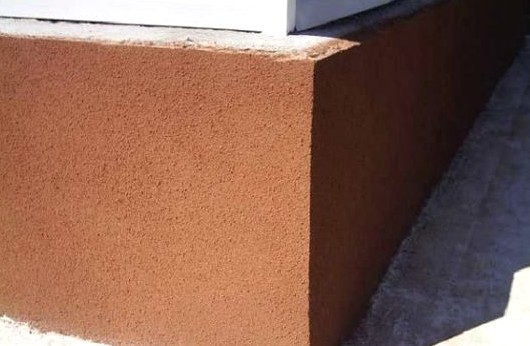
The base must be properly prepared for the upcoming staining - regardless of what paint you decide to use
Types of paints
The problem of how to paint a concrete foundation today is easily solved - the construction market presents a sufficient selection of materials necessary for this, each of which creates protection for the surface in a certain way.
Acrylic
Compositions are emulsion, after final drying they are resistant to water washout. This formulation forms a flexible and stain-resistant layer with excellent adhesion to the surface. The material is based on acrylic resin, sometimes replaced by latex. This paint is recommended for concrete, fiber cement board and basement. Due to the low level of vapor permeability, acrylic paint should not be used on silicate surfaces and lime plaster layers. The concrete base is pre-primed with the composition of the brand of the same name.
Silicone
It is made on the basis of silicone resin, does not form an impermeable membrane after application, it has good vapor permeability and resistance to moisture. Some coloring compositions of this group have self-cleaning properties, after the last rains they remain clean and dry. The compositions are excellent for painting the plastered foundations of a house, brickwork or concrete surfaces, they are used on bases previously painted with silicate compounds.
Epoxy
The paint consists of two components, which dry out due to a chemical reaction between them, combined immediately before application in the established volumetric or weight proportions. Having reached final drying, the paint becomes a reliable protective layer against moisture, oils, solvents and chemical compounds. Epoxy paints are known for excellent adhesion and high mechanical properties.
Polyurethane
The composition is two-component. In terms of its adhesion capabilities, resistance to moisture and solvents, and the strength of the created layer, it has much in common with epoxy paints.
If you are in doubt about how to paint the foundation of the house outside - pay attention to this type of material
Silicate
The bonding element is potash glass in a liquid state, combined with dyes in a dry or dissolved state.The silicate coloring composition does not create a film; when connected to the surface, it adheres to it firmly. The covering layer is even, but the air is permeable. In addition, it protects against the formation of mold and mildew. The paint is recommended for surfaces made of concrete and bricks, "works" on a substrate painted with an inorganic composition. The material is perfectly applied to a damp base.
Alkyd
Such paint is used more often than other types, it has earned popularity at an acceptable cost. The main component is oil. The properties of such paints are easily changed by adding the appropriate ingredients. Phenolic or silicone resins improve gloss, silicone adds water and UV resistance. Due to the oil content, the paint after application creates a good shine, dries quickly, creates an elastic coating that is resistant to weathering. If you are in doubt which paint is best for the foundation, this is an excellent solution to the problem.
Oil
Dries slowly, the consistency resembles a paste or a liquid with pigment particles. It is used in the construction industry and other industrial sectors as a protective or decorative coating. Not sure how to properly paint the foundation with such a composition? Pre-dry its surface and cover with a primer.
Cement
Another paint for concrete foundations, the basis of which is a mixture of light-colored cement mass, pigments and polymers, which give the layer flexibility and improve adhesion. This version of facade paint is considered the cheapest, it perfectly protects against moisture, allows air to pass through, but has a short operating period. Recommended for application on plastered, reinforced concrete or stone surfaces.


